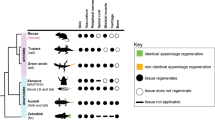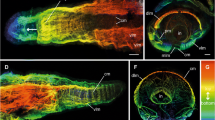Summary
The following résumé brings together the more important features discovered during the course of this work:
-
(1)
The lepidosis of the regenerated tail differs from that of the normal in the fewer number of scale rows and in the presence of the enlarged m d-dorsals in addition to the enlarged mid-ventrals. The normal tail is not segmented externally in correspondence to autotomy planes.
-
(2)
The regenerated tail is lighter-coloured (i.e., more or less pinkish in appearance) and is poor in melanophores.
-
(3)
The general arrangement of the tissues in the tail ofMabuya is similar to that described forHemidactylus, but the subcutaneous fat-layer is entirely absent.
-
(4)
The dermal scutes show inter-connecting bridges and thus go to form an extensive body armour. This feature has not been so far noted by previous authors.
-
(5)
The regenerated tail has also sixteen muscle bundles like the normal.
-
(6)
The cartilaginous tube in the regenerated tail inMabuya does not show any distinction between a central (uncalcified) and a peripheral (calcified) portion, as discovered inHemidactalus.
-
(7)
The cartilaginous tube has occasional large perforations.
-
(8)
The contents of the cartilaginous tube show histologically a similarity to bone-marrow, and do not show any pigment cells.
-
(9)
The sacral vertebræ inMabuya are fused together to form a synasacrum. The anterior two caudal vertebræ have no chevron bones. The inter-central articulations between the caudal vertebrae are inseparable on account of strong ligamentous unions, and the vertebrae are divided by an autotomy plane, which is neither cartilaginous nor hyaline.
-
(10)
The muscle processes are arranged in two lateral series, each consisting of four.
-
(11)
Each autotomy segment is telescoped into the one behind it. There is nodistinct autotomy septum inMabuya as in other lizards—there being only a clear split in the osseous tissue of the vertebrae concerned.
-
(12)
The breaking of the regenerated tail into pieces by vigorous pulling indicates that the caudal muscles here also are arranged in a “dove-tailing” manner. The number of muscle bundles is the same as that found in the normal tail.
Similar content being viewed by others
Bibliography
Ahl, E. “Doppelschwänzige Zauneidechse,”Aquarium, Berlin, 1927, 70–1.
Alonzo, G. “Ricerche sullo sviluppo della coda e degli arti nelGongylus ocellatus,”Atti. Acc. Gioen., 1903, (4)16, No. 5, 48.
Annandale, N. “Contributions to Oriental Herpetology. I. The Lizards of the Andamans, with the description of a new gecko and a note on the reproduced tail inPtychozoon homalocephalum,”Jour. Asiat. Soc. Bengal, 1904,73, 12–22.
Bolkay, St. J. “The rôle of the regenerated tail of the Lacertidæ at the preservation of the species,”Glasn. Zemal. Muz. Bosni Herc. Sarajevo, 1924,36, 91–4.
Boulenger, G. A. “On the Scaling of the Reproduced Tail in Lizards,”Proc. Zool. Soc., London, 1888,1, 351–53.
Brindley, H. H. “On a specimen ofHemidactylus gleadovii Murray with a Bifid Renewed Tail,”Jour. Bomb. Nat. Hist. Soc., 1894,9, 30–3.
— “Some cases of caudal abnormality inMabuia carinata and other lizards,” —, 1898,11, 680–89.
Byerly, T. C. “Note on the partial regeneration of the caudal region ofSphenodon punctatum,”Anat. Rec. Philadelphia, 1925,30, 61–6.
Contejean “Sur l’autotomie chez la sauterelle et le lezard,”C. R. Acad. Sc. Paris, 1890,61, 611–14.
Das, G. M. “Observations on the trifid tails in two specimens ofHemidactylus flaviviridis, Rüppel, with a note on the artificial regeneration of double and triple tails of the ‘Tokhak’ Lizard,Gecko verticillatus, Laurenti,”Jour. Bomb. Nat. Hist. Soc., 1932,35, Pt. 3, 657–62.
Fischer, C. E. C. “Aberration in scales of regrown tail ofAgama tuberculata, Grey,” —, 1907,18, 208.
Fraisse, P. “Die Regeneration von Geweben und Organen bei den Wirbelthieren, besonders Amphibien und Reptilien,”Cassel, 1885.
Fredericq, L. “L’autotomie chez les etoiles de mer,”Revue Scientifique (Ser. 3), 1887,13.
- “L’autotomie ou la mutilation dans le règne animal,”Bull. de l’Acad. roy. de Belgique (Ser. 3), 1893,26.
Gadow, Hans“The Cambridge Natural History Series, Amphibia and Reptiles,” 1901.
Gay, G. “Sulla coda monstruosa delle lacertole,”Monitore zool. ital. Firenze, 1909,20.
Gegenbaur, C. “Untersuchungen zur vergl. Anatomie der Wirbelsäule bei den Amphibien und Reptilien,” 1862.
Giuliani “Sulla struttura del midollo spinale, e sulla riproduzione della corda dellaLacerta viridis,”Roma, Salvucci, 1878.
Gräper, Ludwig “über eine dreischwänzige Eidechse mit sieben Schwanz- skeleten,”Arch. Entw. Mech. Leipzig, 1909,27, 640–59.
Guyénot, E. “Territoire de Régénération chez le Lézard (Lacerta muralis),”C.R. Soc. Biol., Paris, 1928,99, 27–8.
—, and Matthey, R. “Les processus régénératifs dans la patte postérieure du Lézard,”Arch. Entw. Mech. Org., Berlin, 1928,113, 520–29.
Hooker, Davenport “Die Nerven im regenerierten Schwanz die Eidechsen,”Arch. Mikr. Anat., 1912,80, 217–22.
Hora, S. L. “Notes on Lizards in the Indian Museum. III. On the unnamed collection of Lizards of the family Scincidæ,”Rec. Ind. Mus., Calcutta, 1927,29, 1–6.
Hyrtl, J. “Ueber normale Quertheilung der Saurierwirbel,”Sitzb. der Akad. der Wiss. in Wien, 1853, Bd.4, 185.
Lonnberg, Einar “Svansens betydelse och anvandning hos ryggradsdjuren,” (The object and use of tails in the case of vertebrate animals).Fauna and Flora Uppsala, 1910,5, 2–25, 49–71, 118–28.
Mahendra, B. C. “Contributions to the Bionomics, Anatomy, Reproduction and Development of the Indian House-gecko,Hemidactylus flaviviridis Rüppel,”Proc. Ind. Acad. Sci., Sept. 1936,4, No. 3.
Marcucci, Dott. Ermete “Trapianti di pelle e rigenerazione inLacerta muralis,”Archivio Zoologico Italiano, 1932,17, Fasc. 3–4, 435–46.
Milone, S. “Ricerche sulla velocità di accrescimento del midollo spinale della coda di Rettili e Uccelli,”Monitore zool. ital. Forenze, 1922,32, 144–148.
Misuri, Alfredo “Ricerche sulla struttura della coda normale e rigenerata nellaLacerta muralis Merr.,”Roma Boll. Soc. Zool. ital. (Ser. 2), 1910,11, 103–35.
Misuri, A. “Ricerche sulla struttura della coda normale e rigenerata nellaLacerta muralis, Nota I e II,” —, 1911,11, 300–16.
Morgan, T. H.Regeneraton, Macmillan Company, New York, 1901.
Müller, H. “Eine Eidechse, Lacerta viridis mit zwei über einander gelagerten Schwänzen, welche beide als das Product einer überreichen und durch den feineren Bau der wiedererzeugten, bemerkenswerthen Reproductionskraft erscheinen,”Verhandl. d. phys.-med. Gesellschaft in Wurzburg, 1852, Bd.2, 66.
Slotopolsky, B. “Beiträge zur Kenntnis der Verstümmelungs-und Regenerationsvorgänge am Lacertilierschwanze,”Viertelj. Nat. Ges. Zürich, 1921,66, 39–48;Zool. Jahrb. Jena Abt. Anat., 1922,43, 219–322.
Smith, Malcolm A. “Sauria” (The Fauna of British India, including Ceylon and Burma: Reptilia and Amphibia, 1935, 2).
Stuart, G. A. D. “Abnormal tail in a lizard,Hemidactylus gleadovii,”Jour. Bomb. Nat. Hist. Soc., 1908,18, 688–89.
Terni, T. “La rigenerazione del simpatico nella coda regenerata dei Sauri,”Monitore zool. ital. Siena, 1922,33, 58–62.
Tornier, G. “über experimentell erzeugte dreischwänzige Eidechsen und Doppelgliedmassen von Molchen,”Zool. Anz., 1897, Bd.20, 356.
- “über Schwanzregeneration und Doppelschwänze bei Eidechsen,”Sitzungsber. Gesell. Naturfor. Freunde, Berlin, 1897, 59–64.
Tytler, R. C. “Farbenwechsel, die Häutung und die Regeneration des Schanzes bei den Ascalaboten,”Jour. Asiat. Soc. Bengal, 1865.
Werner, F. “über die Schuppenbekleidung des regenerierten Schwanzes bei Eidechsen,”SB. Akad. Wiss. Wien, math.-naturw. Kl., 1896,105, Abt. 1, 123 ff.
- “Selbstverstümmelung bei Heusschrecken,”Zool. Anz., 1892.
— “Selbstverstümmelung und Regeneration des Eidechsenschwanzes,”Wein Wissen für Alle., 1910,10, 17–18.
White, Charles Powell “Regeneration of the Lizard’s Tail,”Jour. Path. Bact., 1925,28, 63–68. (Report of Brit. Assoc. Advancement Science, Manchester, 1915, 472–73).
Woodland, W. N. F. “Some Observations on Caudal Autotomy and Regeneration in the Gecko (Hemidactylus flaviviridis, Rüppel), with notes on the Tails of Sphenodon and Pygopus,”Quart. Jour. Micros. Sci., 1920,65, Pt. 1, 63–100.
Author information
Authors and Affiliations
Additional information
Communicated by Mr. Beni Charan Mahendra,f.z.s.
Thesis approved as part of the requirements for the M.Sc. degree (1938), in the University of Agra.
Rights and permissions
About this article
Cite this article
Sibtain, S.M. Studies on the caudal autotomy and regeneration inMabuya dissimilis hallowell. Proc. Indian Acad. Sci. 8, 63–78 (1938). https://doi.org/10.1007/BF03048201
Received:
Issue Date:
DOI: https://doi.org/10.1007/BF03048201




